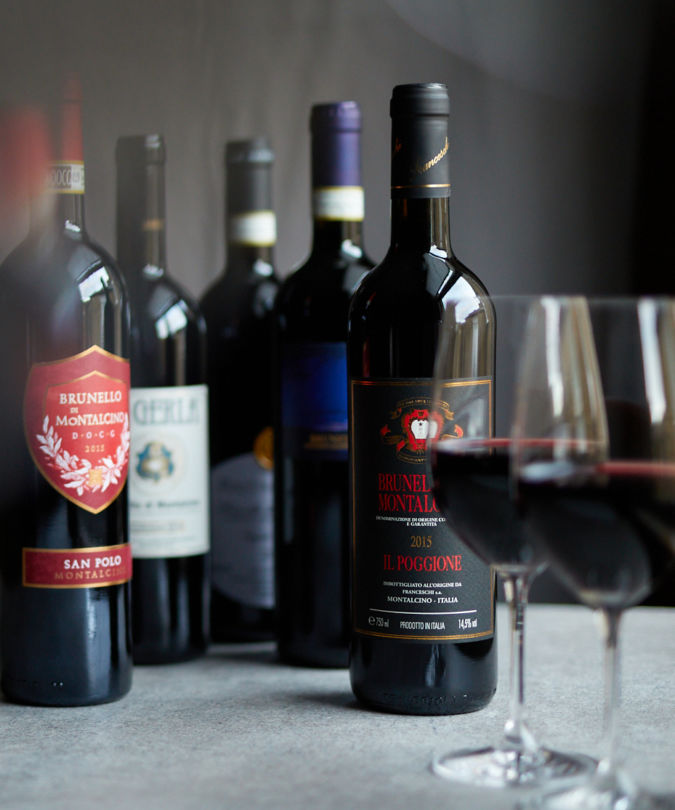Wine merchants and producers alike have been bullish about the quality of the 2016 Brunello di Montalcinos. The local consorzio classified it as a five-star vintage – as it did the 2015 – and it’s true that both are exceptional years, but the wines from these two vintages are very different. It’s also true that recent years have brought a run of good vintages. 2014 was a minor exception – cooler and wetter and yielding fresh, lighter wines which are early maturing. Many producers did not produce a Riserva in 2014, although some of those that did were very happy with the quality. 2013 was very good, with tightly wrought tannins and acidity and focused Sangiovese fruit. 2012 was also very good; the fruit was a little riper and fuller, but less structured. 2011 was a very hot vintage with high alcohol levels and ripe red cherry and strawberry fruit, making for delightful and charming wines in the hands of the right producer or overly alcoholic and quick-to-mature wines in the hands of the wrong one.
So, where does 2016 sit, in particular in relation to what many critics feel was the vintage of the decade, the 2010? Like 2010, ’16 was relatively cool, with a longer ripening season, ensuring complete physiological ripeness. The wines from both vintages are beautifully balanced, with ripe fruit and a classically firm structure. But for me, the best 2016s embody an extra leap forward in quality with regards to the finesse and quality of the tannins, which have a special seamless quality, even in wines so young. I am convinced this is due to producers’ deeper knowledge and understanding of how to get the best from Sangiovese both in the vineyard and the winery, with greater attention to detail in the vineyards, and more focus on achieving balance and harmony. A younger generation of producers has begun to take charge in some wineries in recent years, resulting in plenty of fine-tuning, often including a gentler extraction of tannins. And there has been a move towards single-vineyard wines, resulting in some exceptional quality wines. 2016, in short, is the best of the lot.

Rain at the end of August, followed by the fresh northerly tramontana wind, was key to turning 2016 into a great vintage. The harvest started a week later than recent years, on 14 September, and stretched to mid-October, meaning an even and balanced ripening of the grapes. Cooler nights and a longer, cooler growing season allowed for a brighter, more focused expression of aromas and flavours, and greater phenolic or tannin ripeness. The wines have a brilliant diamond-sharpness, a greater purity of fruit and a more tannic backbone than the 2015s, where the hotter vintage produced richer, more sensuous, but less precise wines.
But even in a single vintage there are a variety of styles, and sub-zones are an important factor. The historic areas of production immediately north and south of the town of Montalcino produce some great wines. The vineyards further north are often at high altitude and cooler, producing wines with high acidity and dark-fruited, forest-floor notes – but they can also be quite austere and earthy, and need time to come around. The south-west sub-zone around the towns of Camigliano and Sant’Angelo is lower in altitude and has a hotter, drier, more Mediterranean climate, yielding wines with lower acidity and more alcohol. The Castelnuovo dell’Abate sub-zone, meanwhile, although south of Montalcino, faces Monte Amiata and benefits from big diurnal temperature differences, resulting in some exquisite wines.

Even more important than the sub-zones are the producers themselves, their philosophies and winemaking skills and whether they grow grapes conventionally, organically or biodynamically. From this kaleidoscope of influences arise at least three main styles, the first being traditional – sometimes austere when young, with high acidity and just-ripe fruit. The wines are matured in large, inert oak and need time to mature. Altesino in the north and Il Poggione and Col d’Orcia in the south fit into this category. A second style takes a modern approach, using some small or new oak in the maturation. These wines are often super-clean, dark, ripe-fruit wines with oak-influenced tannins and oak-spice flavours. Tenute Silvio Nardi and La Gerla fall into this category. Finally, there are the more ethereal, red-fruit, silky textured, one might say Burgundy-style wines such as Salicutti and Stella di Campalto. All three styles have wines to recommend them in 2016.































